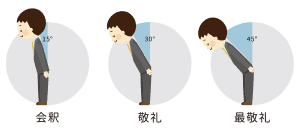Have you ever heard a 45° angle bow, 3-rings rule, Kamiza or Ho-Ren-So? These are indispensable business etiquette rules in Japan, so to speak, common knowledge among Japanese workers. In Japan there is a lot of emphasis on politeness, so the manners in business situations are much stricter than in Western countries. To avoid being impolite to your business partners, we recommend you to know some peculiar rules.
Why does every Japanese business person know such etiquette rules? Almost all Japanese companies give lectures to learn business etiquettes for new graduates before they are engaged in practical work. Some might seem unreasonable or nonsensical for foreigners, but by following such local rules you can show respect to your business partners. It’s as the saying goes “When in Rome, do as the Roman’s do.”(郷に入っては郷に従え)
Bow – different meaning of 3 angles
Japanese formal communication starts and ends with a bow. Physical contact like handshakes is not required, but “a right angle bow” for greeting others is valued. There are three angles to show different level of politeness.

- a slight bow (15°) : to passing colleagues or business partners
- a normal bow (30°) : a general greeting
- a deep bow (45°) : a deep gratitude or apology
Before greeting with a bow, it’s important to stop working, stand up and face your partner. If you initiate a bow, you can even impress others.
Exchanging business cards
There is also a right way how to exchange business cards. Please look at this picture. This is the standard way how to hold your business card.
 How to hold business card when exchanging
How to hold business card when exchanging- Hold your business card with both hands and put your business card under her/his one. So the position of your business card should be lower than your interlocutor as per below picture. By doing that you can show your modesty. This might even lead to a small “fight” who can go lower. That’s ok, if you don’t overdo it.

- For handing over business cards, give it to her/him with your right hand and receive hers/his with your left hand (both cards at the same time).

- After exchanging business cards, it’s very smart if you can make witty small talk about her/his name or position.
For your reference the below image is a bad example which is very rude and unpolite.
Phone etiquette – “3-rings rule”
A phone call must be picked up before the third ring. A research result showed that people start to get frustrated after waiting for an answer on the phone over 11 seconds. 11 seconds is roughly equivalent to three rings. If you couldn’t answer before the third ring, you should say 「大変お待たせしました」(I’m so sorry to keep you waiting so long.) first of all.
After picking up the phone?
The information you have to give to the person on the line are your company name and section name. You should speak nicer and more polite than in a meeting conversation, because your voice or your way of speaking makes the first impression of your company.
[Example]
外線 (on outside line) :「Blablaジャパン (company name) 〇〇部 (section name)でございます」
外線直通(direct call on outside line) : 「Blablaジャパン、△△ (your name) でございます」
内線(on extension) : 「◯◯部です」
内線直通(direct call on extension) : 「◯◯部、△△です」
How to put the call through to your colleague?
You need three pieces of information from the person who called: the name of the person they wishes to talk to, their company name and their name. If you can’t remember all, you have to write them down and give exact information to your colleague.
[Example]
「▲▲ (the person in charge) にお繋ぎしますので少々お待ちください」(Hold on please, I’ll put you through to Ms./Mr. ▲▲.)
What if the person in charge is unavailable?
You should explain that the person is not available right now and if it’s possible, tell when she/he will be back. It’s perfect to suggest that you can leave her/him a message or tell her/him to call back.
[Example]
「▲▲はただいま離席中です。伝言を承りますか?/折り返しいたしましょうか?」(▲▲ is unavailable right now. Do you want to leave ▲▲ a message?/Do you want ▲▲ to call back?)
What are some cautionary points when you leave a message?
If you take notes to leave a message, please keep “5W3H “(When, Where, Who, Why, What, How, How many, How expensive) in the back of your mind and clarify the purpose of the person who called.
Choice of polite words
Japanese has three different types of “Kei-go”.
- 尊敬語 (Sonkei-go) : Honorific language. For talking to your superiors or elders.
- 謙譲語 (Kenjo-go) : Humble language. For talking to your superiors or elders.
- 丁寧語 (Teinei-go) : Polite language. For being formal and polite.
You don’t have to master these three Kei-go perfectly, although knowing some extent about them helps you to work in Japan. When it comes to Sonkei-go and Kenjo-go, even their stems change.
To your superiors, elders or outsiders
Bad : すみません
Good: 申し訳ありません・恐れ入ります
Bad : 了解しました・わかりました
Good: かしこまりました・承知しました
Bad : 知りません
Good: 存じません
Bad : 伝えます
Good: 申し伝えます
Bad : 行きます
Good: 伺います
Bad : どうしますか?
Good: いかがなさいますか?
OK : ご確認をお願いします
Good: ご査収ください
Bad : ご苦労様です
Good: お疲れ様です
Bad : お世話様です
Good: お世話になっております
How to change the meaning of the word from your side to the other?

“Sekiji”: seating plan
Have you ever heard “Kamiza” and “Shimoza”? “Kamiza” is a place where your superiors or elders take a seat, and “Shimoza” is one for subordinates and juniors. Usually a seat the furthest from the entrance is “Kamiza”. Some of the following examples will show you some basic rules, but you should stay flexible to meet the needs of the attendance.
in a meeting room/restaurant

[Kamiza] 1 → 2 → 3 → 4 [Shimoza]
If there are three attendees, “Kamiza” is between 1 and 2. In case this room has a window with a nice view on the right side, the best place to see outside (3 or 4) will be “Kamiza”.
in a taxi

[Kamiza] 1 → 2 → 3 → 4 [Shimoza]
4 is “Shimoza”, because a front passenger has to show the driver the way to the destination and pay the fare as he gets off.
in a plane, Shinkansen(bullet train)/limited express
window seats: [Kamiza] direct by a window → by an aisle → in the middle [Shimoza]
middle seats: [Kamiza] by aisles → in the middle [Shimoza]
Accompanying guests
in an elevator / a lift
when getting in: Push the “open” button from the outside or hold the door by hand → Lead guests and superiors into the elevator → You get in last. Keep standing in front of the operation panel.
when getting off: Keep pushing the “open” button until everyone got off → You get off last. If you are urged to get off before someone, don’t forget to appreciate and say 「お先に失礼します」.
when taking an escalator or using stairs
You should always stand lower than the guests or superiors: behind them when going up, in front of them when going down. One reason for this is, in case of emergency you can support them, for example when they slip or fall down. Another reason is that it’s impolite, if you look down on them.
Visiting a business partner
When you visit an office of your business partner, don’t forget to take your coat off as soon as you enter the building. It should be done before you see your partner at the latest.
Introduce your colleagues to business partners
Introducing your colleagues to a business partner first is considered good manners. Usually the most important person should be introduced last.
your side
- your colleagues
- your boss
business partner side
- the person in charge
- her/his boss
“Ho-Ren-So” (報・連・相)
“Ho-Ren-So” is an abbreviation word that embodies the business attitude in Japan. “Ho” stands for “Hokoku (報告 : report)”, “Ren” for “Renraku (連絡 : communicate) and “So” for “Sodan (相談 : consult)”. Before “Ho-Ren-So” to your boss, don’t forget to ask her/him, whether it’s ok to have time to talk with such phrases like 「今お時間よろしいでしょうか」 or 「ご相談してもよろしいでしょうか」.
”Ho” – report
Reporting the progress of your project or assignment to your boss periodically. The report should be concise and clear, started from the conclusion, then the details and your opinions about that. If you need any, ask your boss for instructions.
”Ren” – communicate
Sharing the coming schedule or problems of projects with your team members. Any delay has to be shared in the team as soon as possible.
”So” – consult
Asking your boss or colleagues for advice as needed. If something is not clear or you can’t solve some problems by yourself, their advice will help you much.
You can also refer to 5 tips to improve your reputation at Japanese company.
Summary
How did you find that? Some might think that such emphasis on manners is too formal and uncomfortable. Of course not all Japanese are willing to follow all rules, but Japanese business communications are based on these manners and you are not able to avoid them for now. If you (want to) work in a foreign company, observing manners is an important skill to adapt in a new place. Etiquette and manners are directly connected with the tradition and culture in a country, so the better you know them, the easier your life and business will be.






















